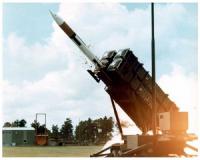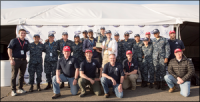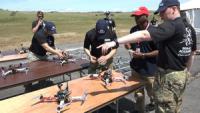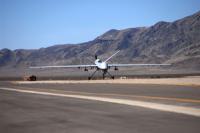-
Counter UAVs to drive enemy drones out of the sky
Defense drones to seek out and bring down hostile military UAVs are being developed in Australia. Military drones have changed the landscape of the modern battlefield in recent years, but the technology to counter them has not kept pace. Reacting to this gap in the market the startup is developing two models in Adelaide, South Australia. The first is a compact counter UAV drone with metal rotors that can be stored in a soldier’s pack and launched when an enemy drone is believed to be in the area.
-
-
Developing autonomous drone swarms for urban warfare
DoD has awarded a team of researchers $7.1 million to develop a drone swarm infrastructure to help the U.S. military in urban combat. The goal is to develop a technology which would allow troops to control scores of unmanned air and ground vehicles at a time.
-
-
Brain-controlled drones are here
Single unmanned autonomous vehicles (UAVs) directed by joysticks, radio controllers, and mobile phones are already accomplishing a variety of useful tasks, such as aerial photography and security patrols. But using multiple drones requires multiple human operators, and this presents a coordination problem. Now a single operator using emerging human-brain interfaces can control a swarm of drones, making possible new classes of applications.
-
-
Israel shot down Iranian-supplied Hezbollah drone in border area

Israel has shot down what an Iranian-supplied Hezbollah drone as it was about to cross the Syrian border into Israel. Analysts note that Hezbollah launched the drone only hours before Prime Minister Benjamin Netanyahu is to address the UN General Assembly. In his speech he is expected to highlight the destabilizing consequences of Iran’s growing influence in the Middle East. “We have seen a significant recent rise in [Hezbollah’s] drone capability,” an Israeli military source said.
-
-
Outdoor drone testing facility for safe, innovative flight testing
An outdoor fly lab for testing autonomous aerial vehicles is coming to the University of Michigan’s College of Engineering this fall, adding to the university’s spate of advanced robotics facilities. M-Air will be a netted, four-story complex situated next to the site where the Ford Motor Company Robotics Building will open in late 2019. Construction of the $800,000 M-Air is expected to begin in August and be complete by the end of the year.
-
-
Tethered drone tested in securing Trump’s vacation golf course in New Jersey
DHS has announced it will test a tethered drone for surveillance over the Trump National Golf Course in New Jersey, where the president is on a 17-day vacation which started on Friday. Tethered drones fly at altitudes of 300-400 feet. The fly autonomously, but an operator on the ground can control the cameras.
-
-
Smart quadcopters find their way on their own -- without human help or GPS
Phase 1 of DARPA’s Fast Lightweight Autonomy (FLA) program concluded recently following a series of obstacle-course flight tests in central Florida. Over four days, three teams of DARPA-supported researchers huddled under shade tents in the sweltering Florida sun, fine-tuning their sensor-laden quadcopter unmanned aerial vehicles (UAVs) during the intervals between increasingly difficult runs. The quadcopters slalomed through woodlands, swerved around obstacles in a hangar, and reported back to their starting point all by themselves.
-
-
Navy tests new mine-detection drone
The new Mine Warfare Rapid Assessment Capability (MIW RAC) system is a portable, remote-controlled system that can detect buried or underwater mines during amphibious beach landings. It’s designed to help explosive ordnance disposal teams quickly find mines and dangerous metal obstacles within coastal surf zones and very-shallow-water zones. MIW RAC consists of a one-pound quadcopter outfitted with an ultra-sensitive magnetometer sensor system to detect mines and provide real-time search data to a handheld Android device.
-
-
Service Academies Swarm Challenge: Expanding the capabilities UAV swarms

More than forty Cadets and Midshipmen from the U.S. Military Academy, the U.S. Naval Academy, and the U.S. Air Force Academy helped expand the capabilities of swarms of highly autonomous unmanned aerial vehicles (UAVs) last month in the Service Academies Swarm Challenge. In the skies over Camp Roberts, an Army National Guard post north of Paso Robles, Calif., each academy demonstrated the innovative offensive and defensive tactics they had developed over the school year. The three-day experiment concluded with an exciting aerial battle in which the Naval Academy took home the win, a trophy, and bragging rights over its rival academies.
-
-
Service Academies Swarm Challenge: Controlling drone swarms

UAVs and other robots have become increasingly affordable, capable, and available to both the U.S. military and adversaries alike. Enabling UAVs and similar assets to perform useful tasks under human supervision — that is, carrying out swarm tactics in concert with human teammates — holds tremendous promise to extend the advantages U.S. soldiers have in field operations. A persistent challenge in achieving this capability, however, has been scalability: enabling one operator to oversee multiple robotic platforms and have them perform highly autonomous behaviors without direct teleoperation. To help make effective swarm tactics a reality, DARPA created the Service Academies Swarm Challenge, a collaboration between the Agency and the three U.S. military Service academies.
-
-
Fuzzy logic to help drones land themselves on moving platforms

The buzzword in drone research is autonomous — having the unmanned aerial vehicle do most or all of its own flying. Researchers are using artificial intelligence, called fuzzy logic, to get drones to navigate and land themselves on moving platforms. This holds promise for commercial uses such as delivering packages.
-
-
SideArm prototype catches full-size drones flying at full speed
Few scenes capture the U.S. Navy’s prowess as effectively as the rapid-fire takeoff and recovery of combat jets from the deck of an aircraft carrier. The ability to carry air power anywhere in the world, and both launch those aircraft to flight speed and bring them to a stop over extremely short distances, has been essential to carriers’ decades-long dominance of naval warfare. To help provide similar capabilities—minus the 90,000-ton carriers—to U.S. military units around the world, DARPA’s SideArm research effort seeks to create a self-contained, portable apparatus able to horizontally launch and retrieve unmanned aerial systems (UASs) of up to 900 pounds. The self-contained, portable apparatus can be used to launch and retrieve unmanned aircraft from trucks, ships, and fixed bases.
-
-
Bird-inspired drone navigation
When they need to change direction, increase their speed, or counter headwinds, birds alter the configuration of their wings. To steer, for example, they spread one wing and slightly retract the other. By adjusting their wingspan in this way, they create a calculated imbalance that causes them to turn. Up to now, only birds could do this so effectively. Researchers have equipped a drone with feathers to increase its precision during flight. The bio-inspired device can spread or close its wings while flying, making it easier to maneuver and more resistant in high winds.
-
-
Using drones, insect biobots to map disaster areas
Researchers have developed a combination of software and hardware that will allow them to use unmanned aerial vehicles (UAVs) and insect cyborgs, or biobots, to map large, unfamiliar areas – such as collapsed buildings after a disaster. “The idea would be to release a swarm of sensor-equipped biobots – such as remotely controlled cockroaches – into a collapsed building or other dangerous, unmapped area,” says one of the researchers.
-
-
Advanced anti-drone protection and neutralization system unveiled
Elbit Systems will use the Israel HLS & Cyber Conference, taking place this week in Tel Aviv, to unveil its ReDrone system, a solution for protection of closed air spaces, national infrastructures, and other critical areas against hostile drones penetrating the protected perimeter. The new system addresses growing global demand for effective – and affordable — airspace protection against hostile drones.
-
- All
- Regional
- Water
- Biometrics
- Borders/Immig
- Business
- Cybersecurity
- Detection
- Disasters
- Government
- Infrastructure
- International
- Public health
- Public Safety
- Communication interoperabillity
- Emergency services
- Emergency medical services
- Fire
- First response
- IEDs
- Law Enforcement
- Law Enforcement Technology
- Military technology
- Nonlethal weapons
- Nuclear weapons
- Personal protection equipment
- Police
- Notification /alert systems
- Situational awareness
- Weapons systems
- Sci-Tech
- Sector Reports
- Surveillance
- Transportation
Advertising & Marketing: advertise@newswirepubs.com
Editorial: editor@newswirepubs.com
General: info@newswirepubs.com
2010-2011 © News Wire Publications, LLC News Wire Publications, LLC
220 Old Country Road | Suite 200 | Mineola | New York | 11501
Permissions and Policies
Editorial: editor@newswirepubs.com
General: info@newswirepubs.com
2010-2011 © News Wire Publications, LLC News Wire Publications, LLC
220 Old Country Road | Suite 200 | Mineola | New York | 11501
Permissions and Policies
